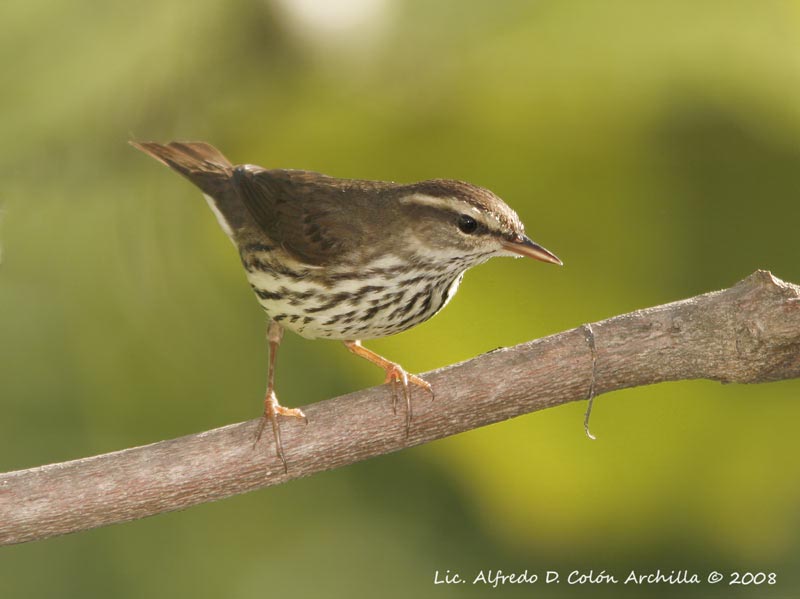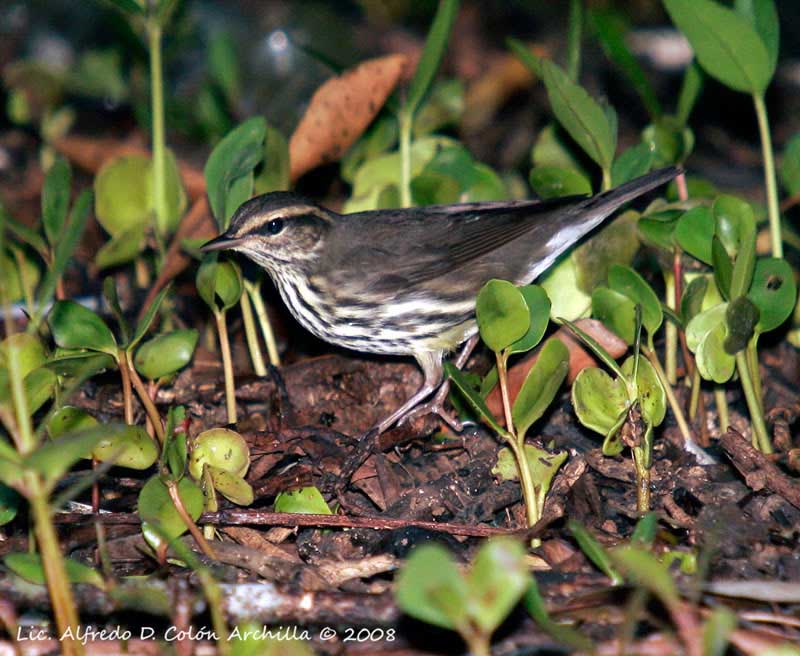
Northern Waterthrush
Parkesia noveboracensis
Passeriforme Order - Parulidae Family
BIOMETRICS:
Length: 12-14 cm ; Wingspan: 21-24 cm ; Weight: 13-25 g
LONGEVITY: 8 years
DESCRIPTION:
Northern Waterthrush is a small songbird, with dark and thin bill, but large for a warbler. Eyes are dark. Legs are brown or pinkish brown. It has unstreaked dull earthy-brown upperparts, pale yellowish –white underparts with heavy dark streaking, and a very conspicuous long buffy-white supercilium extending almost to the nape. It has a white crescent on the lower eyelid. Throat is covered with small triangular marks.
Striking supercilium and plain dark crown easily separate this species from Ovenbird.
Both sexes are similar, and immature is similar to adult.
VOICE: SOUNDS BY XENO-CANTO
Northern Waterthrush’s call is an explosive, sharp, metallic “chink”. Song is a loud, clear series of notes with a lower-pitched but accelerating dropping slightly in pitch “sweet-sweet-sweet-sweet, swee-wee-wee, chew-chew-chew”.
HABITAT:
Northern Waterthrush breeds in waterside or boggy thickets, especially willows and alders, and wooded swamps. At other times, it also frequents mangroves. In migration and winter, it uses a variety of wooded habitats, near water.
RANGE:
Northern Waterthrush breeds from Alaska to Newfoundland, southward to northern United States. It winters from S Florida and Mexico, southward to South America.
BEHAVIOUR:
Northern Waterthrush walks on the ground, skulking in waterside cover, bobbing head and wagging tail as it feeds. It feeds mainly on the ground, and wades in shallow water. Northern waterthrush forages alone, using such tactics as twig-gleaning, flycatching, hovering, chasing, and a lot of pecking. Before leaf emergence, it typically spends about 75 % of its time feeding in water, wading and walking along logs, on branches, and the water’s edges.
During breeding season, males perch in trees near water, while females are feeding below. Males vibrate their wings and raise their crown feathers, and sing. Females may answer with a “chink”. Pair bond is broken after successful fledging.
On the breeding grounds, the male proclaims its territory with its loud and ringing song.
FLIGHT:
Northern Waterthrush has an agile flight, allowing flycatching, hovering and chasing to catch insects.
REPRODUCTION:
Northern Waterthrush male selects the general area, but female chooses the nest site.
Nest is usually in cavity or small hollow under fallen log in a wooded swamp, on the side of a fern clump or under cover along the shores of a lake or river.
Nest includes a cover, like a roof above the nest, and an entrance on the side. Nest is made mainly with moss. Interior of the nest cup is made with grass stems, twigs, or pine needles, and lined with hair of deer, caribou, cow and rabbit.
Female lays about 4 white eggs spotted with brown and grey. Incubation lasts about 12 days, by female alone. Chicks hatch helpless, with tufts of dark blackish down, and they fledge at about 10 days. Both parents feed the young, during about one month, until the chicks begin to feed themselves.
DIET:
Northern Waterthrush feeds on larval and adult insects, spiders and snails, during the breeding season. During spring, birds feed mainly on butterfly larvae. In winter grounds, they consume a great variety of food, with minnows and decapods crustaceans.
PROTECTION / THREATS / STATUS:
Degradation habitat and pesticides are the most important threats for Northern waterthrush. Aerial spraying for the spruce budworm can kill the birds directly, or reduce their preys.
However, populations seem to remain stable despite these threats.
Puerto Rico: Pizpita de mangle
Fr: Paruline des ruisseaux
All: Uferwaldsänger
Esp: Chipe de Agua Norteño
Ital: Tordo acquaiolo del nord
Nd: Noordse Waterlijster
Russe: Речной певун
Sd: Nordlig piplärksångare
Photographs by Alfredo Colón
Puerto Rico Wildlife
Text by Nicole Bouglouan
Sources:
FIELD GUIDE TO THE BIRDS OF NORTH AMERICA by National Geographic Society - National Geographic Society - ISBN: 0792274512
THE HANDBOOK OF BIRD IDENTIFICATION FOR EUROPE AND THE WESTERN PALEARCTIC by Mark Beaman, Steve Madge - C.Helm - ISBN: 0713639601
All About Birds (Cornell Lab of Ornithology)
What Bird-The ultimate Bird Guide (Mitchell Waite)
Wikipedia (Wikipedia, The Free Encyclopedia)
Birds of Nova Scotia (Robie Tufts)
Animal Diversity Web (University of Michigan Museum of Zoology)

